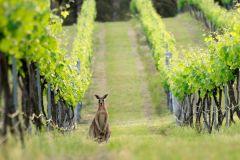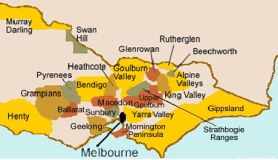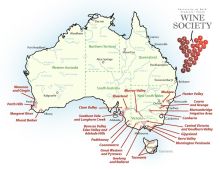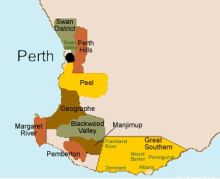The Australian wine industry is the world's fourth largest exporter of wine with approximately 750 million litres a year to the international export market with only about 40% of production consumed domestically.




Wine is produced in every state, with more than 60 designated wine regions totaling approximately 400,000 acres, however Australia’s wine regions are mainly in the southern, cooler parts of the country, with vineyards located in South Australis New South Wales, Victoria, Western Australis, Tasania, and Queensland. The wine regions in each of these states produce different wine varieties and styles that take advantage of the particular terroir, with the
major varieties include Shiraz, Cabernet Sauvignon, Chardonnay, Merlot, Semillon, Pinot Noir, Riesling, and Sauvignon Blanc.
Wines are often labeled with the name of their grape variety, which must constitute at least 85 percent of the wine.
Australia's most famous wine is Penfolds Grange. The great 1955 vintage was submitted to competitions beginning in 1962 and over the years has won more than 50 gold medals. The vintage of 1971 won first prize in Syrah/Shiraz at the Wine Olympics in Paris. The 1990 vintage was named 'Red Wine of the Year' by the Wine Spectator magazine in 1995, which later rated the 1998 vintage 99 points out of a possible 100. Other red wines to garner international attention include Henschke Hill of Grace, Clarendon Hills Astralis, D’Arenberg Dead Arm, Torbreck Run Rig, and other high-end Penfolds wines such as St Henri shiraz.
The information included on wine labels is strictly regulated. One aspect of this is that the label must not make any false or misleading statements about the source of the grapes. Many names (called geographic indications) are protected. These are divided into "South Eastern Australia", the state names zones regions, and subregions.
The largest volume of wine is produced from grapes grown in the warm climate Murray-Darling Basin zones of Lower Murray, North Western Victoria and Big Rivers. In general, the higher-value premium wines are made from smaller and cooler-climate regions.The country has no native grapes, and Vitis vinifera varieties were introduced from Europe and South Africa in the late 18th and early 19th centuries. Some varieties have been bred by Australian viticulturalists, for example Cienna and Tarrango. Although Syrah was originally called Shiraz in Australia and Syrah elsewhere, its dramatic commercial success has led many Syrah producers around the world to label their wine "Shiraz".
About 130 different grape varieties are used by commercial winemakers in Australia. Over recent years many winemakers have begun exploring so called "alternative varieties" other than those listed above. Many varieties from France, Italy and Spain for example Petit Verdot, Pinot Grigio, Pinot Noir, Sangiovese, Tempranillo, and Viognier are becoming more common. Wines from many other varieties are being produced. Australian winemaking results have been impressive and it has established benchmarks for a number of varietals, such as Chardonnay and Shiraz. Moreover, Australians have innovated in canopy management and other viticultural and in wine-making techniques, and they have a general attitude toward their work that sets them apart from producers in Europe.
